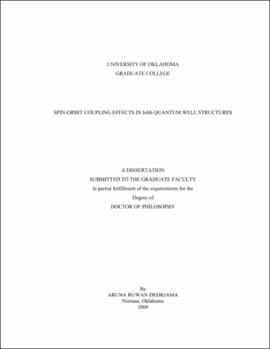| dc.contributor.advisor | Murphy, Sheena | |
| dc.creator | Dedigama, Aruna Ruwan | |
| dc.date.accessioned | 2019-04-27T21:24:11Z | |
| dc.date.available | 2019-04-27T21:24:11Z | |
| dc.date.issued | 2009 | |
| dc.identifier | 99157779602042 | |
| dc.identifier.uri | https://hdl.handle.net/11244/318603 | |
| dc.description.abstract | Indium antimonide (InSb) is a narrow band gap material which has the smallest electron effective mass (0.014m0) and the largest electron Lande g-facture (-51) of all the III-V semiconductors. Spin-orbit effects of III-V semiconductor heterostructures arise from two different inversion asymmetries namely bulk inversion asymmetry (BIA) and structural inversion asymmetry (SIA). BIA is due to the zinc-blende nature of this material which leads to the Dresselhaus spin splitting consisting of both linear and cubic in-plane wave vector terms. As its name implies SIA arises due to the asymmetry of the quantum well structure, this leads to the Rashba spin splitting term which is linear in wave vector. | |
| dc.description.abstract | Although InSb has theoretically predicted large Dresselhaus (760 eVÅ3) and Rashba (523 eÅ2) coefficients there has been relatively little experimental investigation of spin-orbit coefficients. Spin-orbit coefficients can be extracted from the beating patterns of Shubnikov-de Haas oscillations (SdH), for material like InSb it is hard to use this method due to the existence of large electron Lande g-facture. Therefore it is essential to use a low field magnetotransport technique such as weak antilocalization to extract spin-orbit parameters for InSb. | |
| dc.description.abstract | The main focus of this thesis is to experimentally determine the spin-orbit parameters for both symmetrically and asymmetrically doped InSb/InxAl1-xSb heterostructures. During this study attempts have been made to tune the Rashba spin-orbit coupling coefficient by using a back gate to change the carrier density of the samples. Dominant phase breaking mechanisms for InSb/InxAl1-xSb heterostructures have been identified by analyzing the temperature dependence of the phase breaking field from weak antilocalization measurements. Finally the strong spin-orbit effects on InSb/InxAl1-xSb heterostructures have been demonstrated with ballistic spin focusing devices. | |
| dc.format.extent | 108 pages | |
| dc.format.medium | application.pdf | |
| dc.language | en_US | |
| dc.relation.requires | Adobe Acrobat Reader | |
| dc.subject | Nuclear spin | |
| dc.subject | Quantum wells | |
| dc.subject | Semiconductors | |
| dc.subject | Molecular orbitals | |
| dc.subject | Indium antimonide crystals | |
| dc.title | SPIN-ORBIT COUPLING EFFECTS IN InSb QUANTUM WELL STRUCTURES | |
| dc.type | text | |
| dc.type | document | |
| dc.thesis.degree | Ph.D. | |
| ou.group | College of Arts and Sciences::Homer L. Dodge Department of Physics and Astronomy | |
